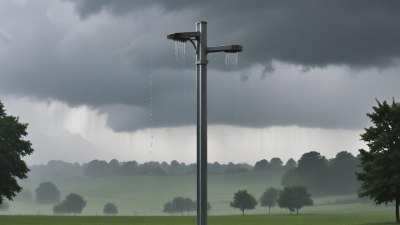The Unspoken Weather Rules of Every Park Picnic Game
Discover the essential weather rules for a perfect park picnic game experience.

Image by prostooleh on Freepik
Picnicking in the park is a beloved pastime, often associated with sunshine, laughter, and bustling games. However, hidden beneath the joy of outdoor activities lies a complex framework of unspoken weather rules that can significantly impact how people enjoy their time outdoors. Understanding these nuances can transform a mere gathering into a memorable day, ensuring you and your friends or family have a delightful experience despite the whims of nature.
Understanding Weather Dynamics
The first step toward a successful picnic game is understanding the weather dynamics of your chosen area. Different parks have unique microclimates influenced by surrounding vegetation, bodies of water, and even structures. Many enthusiasts overlook how these elements affect temperature and wind. For example, parks close to lakes may experience cooler breezes, while heavily wooded parks can feel damp and chilly even on warm days. Always consider the prevailing conditions when planning your picnic.
Temperature Considerations
Temperature plays a crucial role in the enjoyment of outdoor activities. Ideal picnic temperatures typically range between 70°F and 85°F (21°C - 29°C). Above 85°F, people may feel sluggish, while temperatures below 70°F can lead to discomfort, particularly if the wind picks up. It’s wise to check forecasts not just for temperature but also for projected highs and lows, so you dress appropriately and bring along necessary items like sunscreen or jackets.
Rain Predictions
Rain can be picnic enemies, but sometimes it's unpredictable. A forecast predicting a mere 20% chance of rain can still lead to sudden showers. As a result, it's advisable to come prepared with waterproof coverings and have alternate indoor plans. Also, note that the wet ground can affect games—slip and slide may take on new meanings if you engage in soccer or frisbee on a muddy field. Bringing along an ad-hoc game can be a lifesaver!
Windy Conditions
Wind can be both a friend and foe. A gentle breeze can keep you cool; however, strong winds can wreak havoc on picnic setups and outdoor games. If the forecast predicts winds exceeding 15 mph, you might want to secure your items, such as tablecloths and food, carefully. If you and your group plan on participating in activities like flying kites or tossing around a frisbee, ensure the wind conditions are suitable or choose an alternate activity that factors in the wind.
Humidity and Its Effects
Humidity is another often-overlooked aspect. High humidity can make summer picnics feel stifling, while low humidity can lead to dehydration, particularly during physically demanding games. When the humidity is high, hydration becomes crucial. Bring plenty of water and consider light, cool snacks instead of heavy ones that can lead to sluggishness. If you notice signs of discomfort in yourself or others, don’t hesitate to pause the games and hydrate!
Sun Exposure and Safety
Sun exposure is a concern with outdoor events. A picnic can quickly turn sour if sunburn sets in. As a rule of thumb, it’s advisable to apply sunscreen even on cloudy days, as ultraviolet rays can penetrate clouds. Reapply every couple of hours and consider bringing umbrellas or tents for shade. Also, look out for signs of heat stroke or exhaustion, such as headaches or excessive sweating; keep an eye on your pals too!
Preparation for Weather Events
Creating a 'go-bag' for inclement weather can be beneficial. This would include blankets, portable umbrellas, a waterproof tarp, as well as dry clothes. Opt for easy-to-carry items. Games are often fluid and can change according to weather; having a designated area for card games, for example, can give you a backup when outdoor conditions become unfavorable.
Timing is Everything
When you're planning a picnic, consider the timing for when to start games. Morning and late afternoon generally feature milder temperatures, typically avoiding peak hours of heat, so games are more enjoyable. Midday sun can be exhausting; therefore, try to plan more physically demanding games in the cooler parts of the day.
Collective Agreement on Weather Rules
Before you embark on your picnic, have a conversation with your group about expectations when it comes to weather. Establishing a collective agreement on how to handle potential weather disruptions can prevent disagreements down the line. Should the forecast change unexpectedly, how will the group respond? Setting boundaries and guidelines for safety should come first.
Social Media and Weather Updates
In today's digital age, leveraging social media can help you navigate weather updates in real-time. Many weather apps and services provide notifications and live updates. Form a group chat where everyone can share timely information on weather changes. Collaborative planning can often lead to smarter contingency plans.
Flexibility is Key
A picnic is about spontaneity and enjoying the moment. While it's vital to prepare for various weather conditions, it's equally important to stay flexible. Maybe a sudden drizzle turns a picnic into a wet and wild slip-and-slide contest, or unexpected clouds give way to a spectacular sunset. Embrace the quirks of weather; sometimes, the best stories come from unplanned moments!
Wrapping Up the Day
As the sun sets on your picnic day, and you start packing up, take a moment to reflect on the day's events. Did the weather affect your games? How did your group adapt? Sharing experiences and insights can foster anticipation for the next picnic and future gatherings. Every event creates memories that need recounting, and learning from one's experiences is invaluable.











